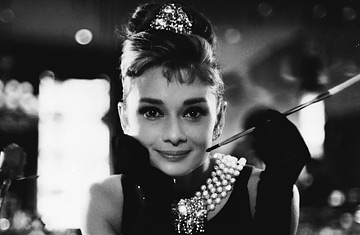
Audrey Hepburn (1929 - 1993)
(2 of 2)
Anyway, the camera loved her natural glamour: the doe eyes, the perfection and intelligence of her mouth. And she trusted the camera to capture the subtle shades of delight or disapproval - passion rendered with delicacy. In Sabrina she must spend most of her time hiding her true feelings from two men who can't decide if they love her. The whole enchanting performance, like so many that would follow, is a private conversation between Hepburn and her 35mm confidante.
Hepburn women were often women apart, like the Green Mansions Bird Girl, quarantined in her aviary. Race was the improbable barrier in The Unforgiven, where she got a great tan to play Burt Lancaster's "l'il red-hide Injun," the pretty pelt in a sociological showdown.
THE DAUGHTER-LOVER
The more common hurdle for a Hepburn heroine was age. Time and again, Hollywood accented her gamine charm by teaming her with male stars who could have been her father. Half of her first dozen leading men were 20 to 30 years older than she: Humphrey Bogart (54 to her 25) in Sabrina, Henry Fonda (51 to her 26) in War and Peace), Astaire (58 to her 28) in Funny Face, Gary Cooper (56 to her 28) in Love in the Afternoon, Cary Grant (59 to her 34) in Charade, Rex Harrison (56 to her 35) in My Fair Lady.
Perhaps the men who directed her in this period (and all but four of them were over 50) determined that her age was no hurdle at all for Hepburn - that a connoisseur's maturity was needed to appreciate her unique vintage. She was courted on screen by nearly every hunky Hollywood relic until, in The Nun's Story, only God could be her best beau.
Breakfast at Tiffany's set Hepburn on her 60s Hollywood course. Holly Golightly, small-town Southern girl turned Manhattan trickster, was the naughty American cousin of Eliza Doolittle, Cockney flower girl turned Mayfair Lady. Holly was also the prototype for the Hepburn women in Charade, Paris When It Sizzle and How to Steal a Million: kooks in capers. And she prepared audiences for the ground-level anxieties that Hepburn characters endured in The Children's Hour, Two for the Road and Wait Until Dark.
Now she was co-starring with men her own age, or at least her own generation. George Peppard, in "Tiffany's", and James Garner, in "The Children's Hour", were a year older. Peter O'Toole, in "How to Steal a Million", was three years younger, and "Two for the Road"'s Albert Finney seven years her junior - and the first Audrey co-star who seemed ready to treat her as a sex object. Yet to find someone whose roguish masculinity complemented her ethereal femininity, she would have to come out of retirement in 1976 for Sean Connery and Robin and Marian.
She made a few more film appearances, the last one indelible: as Richard Dreyfuss' adviser from Heaven in Always. It was a visitation from the guardian angel of our finest instincts.
FAIR LADY
For most of her life she managed to evade tabloid crossfire that signifies modern celebrity. The reign of Hepburn was mainly on the screen. She married an actor, Mel Ferrer, then she married a doctor; she had two sons, both attending her when she died. People near her said she was not treated well by her men until she found Robert Wolders, her companion for her last, most difficult decade.
And always she took seriously the responsibility of being Audrey Hepburn. Greeting her admirers at a Museum of Modern Art tribute in 1990, she she was elegant, direct, indulgent to the attention paid her. Like the reporters lined up to meet Princess Ann, we felt privileged to be in her regal presence. Serene Majesty: it was what she was and what she possessed.
"Radiance is the word," Joe Ferrer, a Time editor of the 80s and 90s who is Mel's nephew, wrote to me in an email just after Hepburn's death. "As a person, too. Though I don't think I saw her more than once after the divorce, she maintained a warm and sturdy bond with my mother. She was an exceptional person, kind, caring, involved and strong. She was someone you wished you could be like - a person who, so far as I could see, was even better than she appeared to be."
In great acting, we see the soul of the character through the craft of the performer. In a great star, we see the personality of the performer through the veil of the character. The actor disappears, the star displays. Hepburn did both. She always illuminated the parts she played; those young women won a unique allure because she played them. But she was also, and utterly, herself. What a gift to the earth that was, from the movies' last and best lady.
In Paul Rudnick's wonderful new play "Regrets Only", the dress designer played by George Grizzard enunciates the difference between style and fashion. "Fashion is for followers," he says. "Style you create for yourself." Audrey Hepburn created, embodied, her own fabulous style. Here's hoping it never goes out of fashion.
